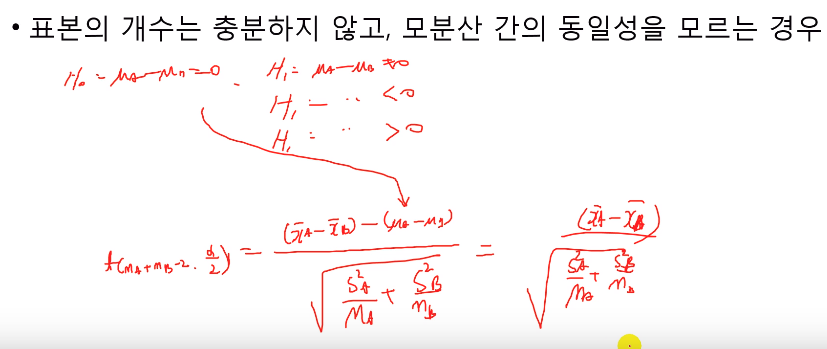================================================================================
- Not enough sample
- Sample populations variance
================================================================================
Required assumption
- 2 populations should have "normal distribution" or "similar normal distribution"
$$$\mathcal{N}(\mu_A,\sigma_A^2)$$$
$$$\mathcal{N}(\mu_B,\sigma_B^2)$$$
$$$\sigma_A^2=\sigma_B^2=\sigma^2$$$
$$$s_A^2=s_B^2=s^2$$$
================================================================================
Pooled variance estimator $$$S_p^2$$$
- There are populations
- They are independent
- Pooled variance estimator is expressed by "unbiased estimator of comman variance"
================================================================================
 $$$n$$$: number of populations
$$$n_i$$$: sample size
================================================================================
$$$n$$$: number of populations
$$$n_i$$$: sample size
================================================================================
 In both sided test, confidence interval
$$$(\bar{x}_A - \bar{x}_B) - t_{(n_A+n_B-2,\frac{\alpha}{2})} S_p \sqrt{\frac{1}{n_A}+\frac{1}{n_B}} \le
\mu_A-\mu_B \le
(\bar{x}_A - \bar{x}_B) + t_{(n_A+n_B-2,\frac{\alpha}{2})} S_p \sqrt{\frac{1}{n_A}+\frac{1}{n_B}}$$$
================================================================================
Let's establish hypothesis
In both sided test, confidence interval
$$$(\bar{x}_A - \bar{x}_B) - t_{(n_A+n_B-2,\frac{\alpha}{2})} S_p \sqrt{\frac{1}{n_A}+\frac{1}{n_B}} \le
\mu_A-\mu_B \le
(\bar{x}_A - \bar{x}_B) + t_{(n_A+n_B-2,\frac{\alpha}{2})} S_p \sqrt{\frac{1}{n_A}+\frac{1}{n_B}}$$$
================================================================================
Let's establish hypothesis
 test statistic t
================================================================================
Case
- Not enough sample
- No information about variance
- That is, you don't know variance uniformity of populations
$$$\bar{x}_{A} - \bar{x}_{B}$$$
$$$E(\bar{x}_A - \bar{x}_B) = E(\bar{x}_A) - E(\bar{x}_B) = \mu_A-\mu_B$$$
$$$s^2(\bar{x}_A - \bar{x}_B) = s^2(\bar{x}_A) + s^2(\bar{x}_B) - 2Cov(\bar{x}_A-\bar{x}_B) = \frac{s_{x_A}^2}{n_A} + \frac{s_{x_B}^2}{n_B}$$$
================================================================================
Confidence interval (when variance uniformity is unknown)
test statistic t
================================================================================
Case
- Not enough sample
- No information about variance
- That is, you don't know variance uniformity of populations
$$$\bar{x}_{A} - \bar{x}_{B}$$$
$$$E(\bar{x}_A - \bar{x}_B) = E(\bar{x}_A) - E(\bar{x}_B) = \mu_A-\mu_B$$$
$$$s^2(\bar{x}_A - \bar{x}_B) = s^2(\bar{x}_A) + s^2(\bar{x}_B) - 2Cov(\bar{x}_A-\bar{x}_B) = \frac{s_{x_A}^2}{n_A} + \frac{s_{x_B}^2}{n_B}$$$
================================================================================
Confidence interval (when variance uniformity is unknown)
 ================================================================================
Establish hypothesis and create statistic t
================================================================================
Establish hypothesis and create statistic t





